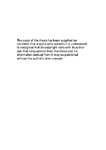Being Vulnerable: Distances of the Sublime Anthropocene
| dc.contributor.supervisor | Baugh, Thomas | |
| dc.contributor.author | Hopes, Laura | |
| dc.contributor.other | School of Art, Design and Architecture | en_US |
| dc.date.accessioned | 2021-01-21T12:50:14Z | |
| dc.date.available | 2021-01-21T12:50:14Z | |
| dc.date.issued | 2020 | |
| dc.identifier | 10272252 | en_US |
| dc.identifier.uri | http://hdl.handle.net/10026.1/16812 | |
| dc.description.abstract |
This project by the artist and researcher Laura Hopes develops from a methodology built around the idea of the ‘vulnerable practitioner’, open to failure, seeking collaboration and acceptant of unknowns. Her practice has become, through collaboration with others and her own acceptance of vulnerability, a slower, lengthier process, where her assumptions are constantly challenged and obstacles unpicked. The project’s expanded practice encompasses writing, conversations, film, performance, installation and multi-disciplinary exchange. Using these diverse tools, she investigates, through artistic research, what has traditionally been understood by the terms Sublime and Anthropocene and seeks to understand where their meanings may have coincided throughout the geologic and human history of this era, the Anthropocene. This project explores these terms within the philosophical categories of the Sublime namely; aesthetics, rhetoric, and distance, with particular focus upon human use of land; through agriculture, extraction, dispossession, ruination and practices of settlercolonialism. Hopes reviews and argues for a synonymy between these terms through the lens of her collaborative practice within three specific projects; Marginalia, Ruins and Speedwell. During this process of moving through different distances of time and physical distances of engagement, she tentatively uncovers possibilities for a ‘new’ Sublime Anthropocene. It is telling that the artistic projects, forged through collaboration, remain to a degree unfinished, always offering a further possibility. This Sublime Anthropocene is acknowledged through a more evenly distributed precarity among and between species, a rupture of linear models of distant history in favour of a layered and ongoing temporality, and a polyvocality which offers space for multiple ‘tellings’ of these experiences. Hopes offers no easy solutions to this time of environmental and societal crisis but instead suggests that vulnerability and an openness to unknowing may be a more powerful response than false forms of ‘solutionism’, where the solution will suit the solver, or at best be done on behalf of others. | en_US |
| dc.language.iso | en | |
| dc.publisher | University of Plymouth | |
| dc.rights | Attribution-NonCommercial-NoDerivs 3.0 United States | * |
| dc.rights.uri | http://creativecommons.org/licenses/by-nc-nd/3.0/us/ | * |
| dc.subject | Anthropocene Sublime Vulnerability | en_US |
| dc.subject.classification | PhD | en_US |
| dc.title | Being Vulnerable: Distances of the Sublime Anthropocene | en_US |
| dc.type | Thesis | |
| plymouth.version | publishable | en_US |
| dc.identifier.doi | http://dx.doi.org/10.24382/1204 | |
| dc.identifier.doi | http://dx.doi.org/10.24382/1204 | |
| dc.rights.embargoperiod | No embargo | en_US |
| dc.type.qualification | Doctorate | en_US |
| rioxxterms.funder | Arts and Humanities Research Council | en_US |
| rioxxterms.identifier.project | 3D3 Centre for Doctoral Research | en_US |
| rioxxterms.version | NA | |
| plymouth.orcid.id | orcid.org/0000-0002-5751-1245 | en_US |
Files in this item
This item appears in the following Collection(s)
-
01 Research Theses Main Collection
Research Theses Main



